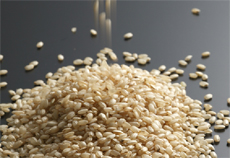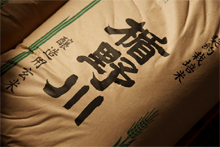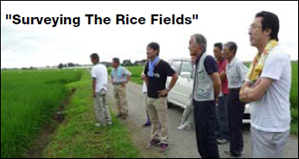An In Depth Guide to "TATENOKAWA"
Volume 3 is all about the rice we use for brewing.
Volume 3 - Rice For Brewing

What is the Best Type of Rice For Brewing Sake?
Rice that was developed to be suitable for use in sake brewing is referred to as ‘special rice for brewing’, or ‘sake rice’ for short. The grains are bigger than that of table rice, contain less protein and have an opaque white nucleus in the centre, which is rich in starch, called a shinpaku (LIT:white heart).
Before sake production can begin, in order to reduce the number of off flavours in the end product as much as possible, the outer edges of the rice are polished away (similar to milling of coffee beans). The best type of rice for making sake is explained further below.
- Exterior: A large grain that is easy to polish.
- Interior: Presence of a white heart in the centre.
- Suitability for sake production: Proportion of white heart, rice polishing threshold, amount of protein, water absorption capacity, koji suitability, etc.
The Reason for Using Rice Grown in Yamagata Prefecture

Sake rice production is a labour intensive task and the maximum crop yield per 992sqm is extremely limited, making it much more expensive to buy than table rice. Presently, there are over 100 types of sake rice but for the reasons explained below, 80% of our sake is made using Yamagata Prefecture local varieties Dewasansan and Miyama Nishiki.
- Boasting large expanses of arable land, the Shonai area has always been blessed with plentiful rice production so we wanted to contribute to the local agriculture as much as possible.
- Using locally grown rice to produce sake that conjures images of the local scenery helps to put Yamagata Prefecture on the map and promote it globally.
- From the production of the rice to the production of the sake, we want the people who make it to be at the forefront.
Dewasansan and Miyama Nishiki
A Summary of Both Sake Rice Types:
| Dewasansan | Miyama Nishiki | |
| The Origin of the Rice | Created in a Yamagata Prefecture test laboratory, in 1985, it is a hybrid of Miyama Nishiki and Hanafubuki; both of which are also varieties of sake rice. | Discovered in a Nagano test laboratory, in 1972, it is the result of exposing Takane Nishiki to gamma radiation. It was first recognised as a superior type of sake rice in Yamagata Prefecture, in 1998. |
| Characteristics | Compared to Miyama Nishiki, the white heart is bigger; it's lodging resistance, cold resistance and water absorption are all superior. It is harvested much later than Miyama Nishiki. | Because of its resistance to cold temperatures, it is a popular type of rice in the North East of Japan. The rice is harvested much earlier than Dewasansan. |
| Origin Of The Name | Yamagata Prefecture boasts over 33 mountain ranges over 1000m high, among which, includes Mt. Chokkaisan (2236m), one of the top 100 most famous mountains and scenic wonders in Japan. Therefore it was only fitting that the signature rice of the region should be given an equally impressive name. | The name, Lit: Beautiful Mountain, comes from the fact that the white heart reminds people of the snow-capped peaks of the Northern Alps. |
| Effect on Sake Quality | This sake rice is comparatively softer and so there is more of its flavour in the end product. | This sake rice is comparatively harder and so there is less of its flavour in the end product. |
The Conditions Required For Sake Rice Cultivation.
A grain of sake rice is much bigger than that of table rice, therefore the stem has to be taller and the ear longer but this makes the plant much more likely to fall down. A successful harvest requires the following 4 conditions to be met.

- 1. A place with morning to evening extremes of hot and cold.
- 2. A soil rich in nutrients.
- 3. The seeds must be laid at intervals to allow for sufficient sunlight and breathing space.
- 4. Sufficiently skilled farmers with the right technology to hand.
Contracted Farming
In 2005 we began establishing contracts directly with local farmers. The raw ingredients of Junmai Daiginjo are rice and water. The rice plays a huge part in determining the quality of the end product and yet so many breweries rely on rice suppliers and brewer's associations for procurement.
With a lack of young people to take over the reins — a result of an ageing population problem— sake rice farming faces a very uncertain future, so much so that we were worried that in the future a stable supply of good quality rice might simply disappear. The fact that we source our rice locally and polish it in house is nothing more than one of the fundamentals of sake production. We conducted an interview with the farmers that make our sake rice.
Q1: What are the differences between sake rice and table rice?

A1: Compared to table rice, we have to grow the stem thicker and shorter to support a longer ear. 30% of the end product is decided at the seeding stage. Furthermore, the grains are much bigger making them much more susceptible to invasion by insects and it is much more likely that the plant will fall down.
One other factor that makes cultivation difficult is that a portion of the white heart is determined by the weather. Each and every rice field is different so experience and skill is very important.
Q2: In Japan as a whole, a lack of sake rice is becoming a big problem, how do you see the situation?
A2: Regulations on farming were recently lifted allowing us to resume cultivation of rested fields. Even though the price of table rice continues to fall, the price of sake rice remains stable and we already have a buyer who is able to take shipment as soon as the rice has been harvested so contracted farming works very well for us.
Q3: What else are you doing to ensure a good rice crop?

A2: In 2010, we setup a sake rice research organisation that conducts a tour of all the contracted rice fields and exchanges information about once a year to help ensure good quality rice and a stable supply. We believe that the loyalty that comes from a deeper communication among the individual farmers and with the sake breweries has created stability that has enabled us to produce good quality. The organisation is made up of 11 members making Dewasansan and 7 making Miyama Nishiki.
Reference Materials
- References about sake rice - Yamagata prefecture sake rice cultivation reform council
- Brewery textbooks - Brewing society of Japan
- Sake production techniques - Brewing society of Japan
- Sake fundamentals - NPO & FBO foundations
- Textbook on sake rice cultivation - ASK rice cultivation society
- Wikipedia (Free online encyclopaedia)

